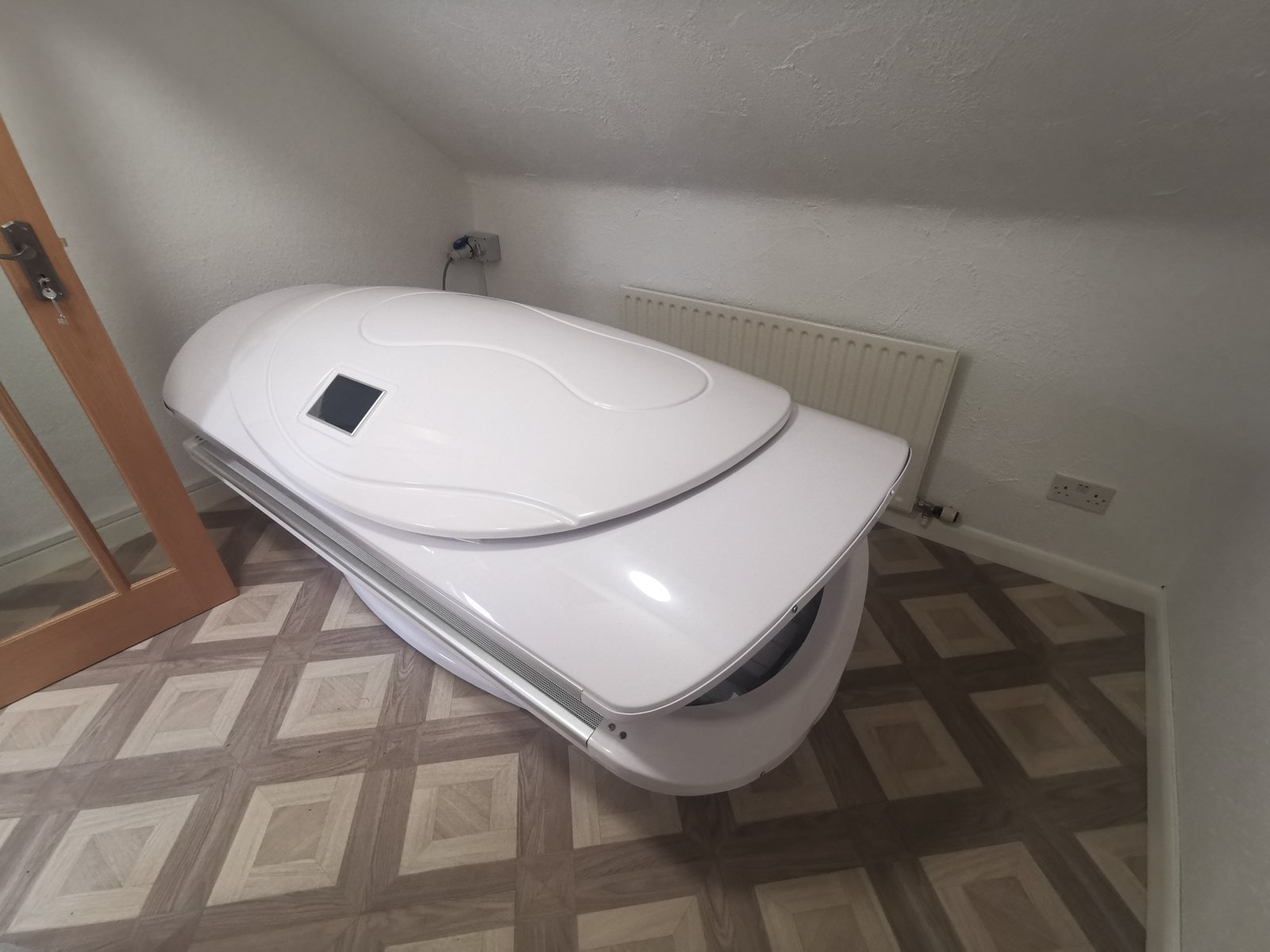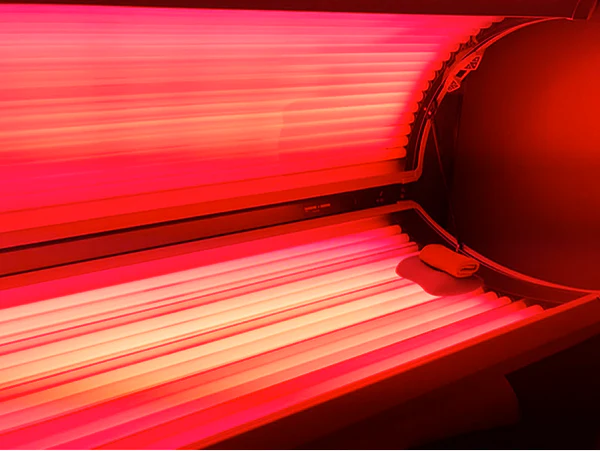Red Light Therapy – Red Light Bed with Near Infrared Wavelengths
DISCLAIMER: WE DON'T TREAT, DIAGNOSE, OR CURE ANY DISEASES IN THE WELLNESS CENTER.
Bed Specifications: Wavelengths available: 633nm, 660nm, 810nm, 830nm, 850nm, 940nm. Light source: Red + NIR. Pulsed: 1 - 15000Hz.
Introduction to Light Therapy Light therapy, a versatile therapeutic method employing specific wavelengths of light, has garnered considerable interest for its potential in addressing a wide array of health conditions. While its applications are promising, ongoing research is crucial to comprehensively understand its effectiveness and safety profile.
Red light therapy, also known as low-level laser therapy (LLLT), low-power laser therapy (LPLT), and photobiomodulation (PBM), employs specific wavelengths of light to address a wide range of health conditions. Its effectiveness and safety continue to be the subject of ongoing research.

Understanding How it Works: Red light therapy works by stimulating cellular responses through targeted wavelengths of light. This can enhance cellular function, promote regeneration, and support various biological processes. The interaction with mitochondria, the "power plants" of cells, potentially boosts cellular energy, thus supporting overall well-being and skin health.
The purported mechanism behind red light therapy revolves around its interaction with the mitochondria, often referred to as the "power plants" of cells. By providing additional energy to these cellular structures, red light therapy is believed to enhance various cellular processes, leading to improvements in skin health and overall well-being.

Specific Mechanisms:
- Stimulating Collagen Production:Collagen is a vital protein responsible for providing structure, strength, and elasticity to the skin. Red light therapy may stimulate the production of collagen, thereby promoting skin rejuvenation and reducing the appearance of wrinkles and fine lines.
- Increasing Fibroblast Production:Fibroblasts are cells responsible for synthesizing collagen and other extracellular matrix components. By increasing fibroblast activity, red light therapy may facilitate the production of collagen, aiding in the repair and regeneration of skin tissue.
- Enhancing Blood Circulation:Red light therapy has been suggested to increase blood circulation to the treated area. Improved blood flow can contribute to better oxygen and nutrient delivery to the skin cells, supporting their metabolic processes and promoting overall skin health.
- Reducing Inflammation:Red light therapy may have anti-inflammatory effects at the cellular level. By reducing inflammation within the cells, it can help alleviate skin conditions characterized by inflammation, such as acne and psoriasis, and promote a healthier skin environment.
In summary, red light therapy is believed to exert its beneficial effects on skin health by stimulating collagen and fibroblast production, improving blood circulation, and reducing inflammation within the cells. These mechanisms work synergistically to promote skin rejuvenation, repair damaged tissue, and enhance overall skin complexion.
Evolution of Light Therapy: The evolution of light therapy spans decades, from its accidental discovery to its diverse applications across medical, dermatological, and therapeutic fields. Advances in technology, including the development of light-emitting diodes (LEDs), have expanded the possibilities and accessibility of light therapy.
Research conducted over the past two decades suggests a wide array of potential benefits associated with Red Light Therapy (RLT):
- Enhanced Wound Healing and Tissue Regeneration: RLT may expedite the healing process of wounds and facilitate tissue repair.
- Mitigation of Cancer Treatment Side Effects: RLT shows promise in alleviating adverse effects of cancer treatment, such as oral mucositis, radiation dermatitis, and lymphedema, thereby improving patients' overall well-being.
- Stimulation of Hair Growth: RLT has been indicated to promote hair growth, offering potential relief for individuals with androgenic alopecia.
- Short-Term Relief for Carpal Tunnel Syndrome: RLT has been explored as a short-term treatment option for carpal tunnel syndrome, a condition characterized by hand numbness and weakness.
- Slowing Myopia Progression: Research suggests that RLT may slow down the progression of myopia, providing a non-invasive approach to managing this vision condition.
- Alleviation of Psoriasis Lesions and Burn Scars: RLT has been investigated for its potential to reduce the severity of psoriasis lesions and improve the appearance of burn scars.
- Relief from Neuropathic Pain: RLT has demonstrated efficacy in alleviating neuropathic pain, offering relief to individuals suffering from nerve-related discomfort.
- Improvement in Neural Function and Protection: Studies indicate that RLT may enhance neural function and protect against cognitive decline, particularly beneficial for individuals with Alzheimer's disease and other neurodegenerative disorders.
- Enhancement of Skin Complexion and Collagen Production: RLT has been shown to enhance skin complexion by boosting collagen production, diminishing wrinkles, and rejuvenating the skin.
- Alleviation of Pain and Inflammation: RLT exhibits anti-inflammatory properties and may provide relief from pain and inflammation, including conditions like Achilles tendon pain.
Additionally, RLT can be combined with photosensitizing medications for photodynamic therapy, enhancing its effectiveness in certain cancer treatment approaches. Despite being generally considered safe and painless, there remains a lack of consensus among experts regarding its efficacy in cancer treatment. While many studies, including one from 2018, suggest that RLT may help manage negative side effects of cancer treatments such as oral mucositis and radiation dermatitis, there are still uncertainties surrounding its direct impact on cancer cells.
Reports of adverse effects from RLT use include instances of burns, lesions, and blistering. These events have been observed in individuals who used RLT units for extended periods, fell asleep with the device in place, or experienced device malfunction due to broken wires or corrosion. Additionally, there is a potential risk of eye damage associated with RLT. While LEDs pose less risk to the eyes compared to traditional lasers, it is recommended to wear proper eye protection during RLT sessions to minimize any potential harm.
It is important for individuals considering RLT to weigh the potential benefits against the associated risks and to consult with healthcare professionals before initiating treatment, particularly if they have underlying health conditions or concerns. Light therapy offers a spectrum of potential benefits, including promoting wound healing, facilitating tissue repair, and mitigating symptoms associated with certain health conditions. Studies have demonstrated its efficacy in addressing concerns such as pain management, skin rejuvenation, and mood disorders. However, as with any therapeutic intervention, potential risks and limitations exist, underscoring the importance of evidence-based practice and careful consideration of individual circumstances.
